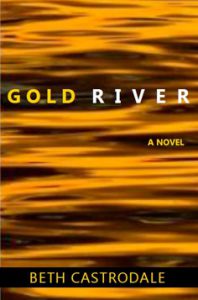The fictional cemetery in my novel In This Ground is based largely on Forest Hills Cemetery, which is about two miles from my apartment in Boston.
Why, you might ask, was Forest Hills Cemetery such an inspiration? As one character says of the graveyard in my book, stepping into FHC is “like entering some kind of weird, twisty dream.” Visitors can retreat from ordinary life and become pleasantly lost, both in physical space and in their thoughts. Also, like the cemetery in my book, FHC seems to exist on some other plane than the ordinary world and thus is open to the imagination in unexpected ways.
In this post, I’ll share a few of my favorite sites/sights from FHC, and brief observations about each.
First, a little background on the cemetery …
Forest Hills Cemetery was founded in 1848 as part of the garden, or rural, cemetery movement: a nineteenth-century trend of developing graveyards that look as much like Victorian-era parks as places to bury the dead.
To quote from Anthony Mitchell Sammarco’s history of the cemetery, Victorians believed that “nature offered special keys for unlocking the mysteries of life and death,” and the grounds took shape from “a radical plan for burial and commemoration that linked nature, landscape design, and horticulture with art and architecture.” The intention was to both honor the dead and provide solace for the living.
Given the aim of providing solace, the death’s-head imagery common in older New England graveyards is nowhere to be found in Forest Hills Cemetery. In its place are stone works with nods to nature (featuring images of, say, ferns or ivy) or classical architecture.
My favorite grave markers (and a couple of things I’m not so fond of)
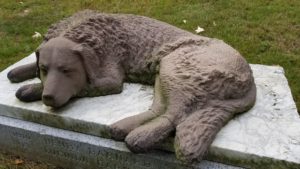
Anything with creatures—especially dogs. Sculptures of lambs sometimes appear on the graves of children, for obvious–and heartbreaking–reasons. Rarer are sculptures of dogs—the so-called Barnard dog being my favorite.
Little is known about the couple buried at this gravesite: Henry Barnard, a shoemaker who died in 1853, and his wife, Lucretia, who died in 1913. According to information from the cemetery, Lucretia chose the sculpture to honor her husband—for reasons that aren’t recorded anywhere, to my knowledge. But some beloved dog (or dogs) must have factored into the decision.
Whenever I see this pup of stone (a Newfoundland, apparently), I always get a little weepy, especially when it’s surrounded by snow, and seemingly abandoned by comforts like a sunny stretch of grass or a radiator-warmed rug. At these times, I try to tell myself that this dog exists apart from the seasons, a reminder of what it is to feel comfortable and at home.
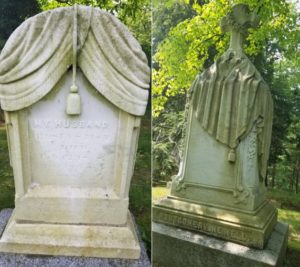
Anything with drapery. In cemetery markers and monuments, drapery is said to represent grief and mourning. According to information from the renowned Lakewood Cemetery, “Some believe that draping represents the collapse of the partition between life and death, while others believe it represents the shroud left after the soul departs the body.”
But whenever I see draped grave markers or monuments at Forest Hills Cemetery, I always wonder if the bereaved were trying to leave their loved ones with some type of creature comfort, if only symbolically, tucking them in against the chills of the grounds.
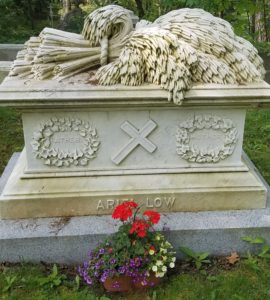
Most any representation of nature. Again, images of nature were common in the garden, or rural, cemetery movement. One of my favorite examples of nature-in-stone is the Ariel Low gravesite at Forest Hills Cemetery.
I love the detail and artistry of the stone work, especially of the wheat atop the sarcophagus. According to information from the cemetery, Low was a dealer in leather goods in nineteenth-century Boston. “The sheaf of wheat refers to the fact that Low had a prosperous, successful and long life, and that his ‘harvest’ was now in. … The ivy refers to things like friendship, fidelity, and everlasting life.”
Mysterious gravestones. For me, the saddest marker of this type is engraved just with “Little Charlie – 1860-1861.” On the one hand, this stone raises lots of questions: Who was Charlie, and what memories of him did his family hold on to? What took him from the world so quickly? On the other hand, the words and the span of years say everything that needs to be said to strangers like me. The rest belongs only to Charlie, and to those who loved him.
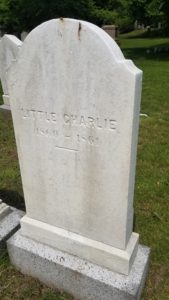
Things I’m not so fond of. Obelisks, obelisks, obelisks. Thanks, in part, to the Egyptian Revival, the grounds of Forest Hills, and many other nineteenth-century cemeteries, fairly prickle with them. But they do nothing for me. Why? I can’t really say, though I suspect associations with Washington, D.C.—in particular, with the indifferent, large-scale brutalism of so many (but not all) of its buildings and monuments.
I’m also put off by single-occupant, mansion-like mausoleums, which seem like ideal places to recite “Ozymandias.” Although they’re far from the only self-aggrandizing gravesites in the cemetery, they’re the only ones that get me muttering about death being the great equalizer. (Not the kindest instinct, I realize. But I can’t help myself.)
My favorite works of art
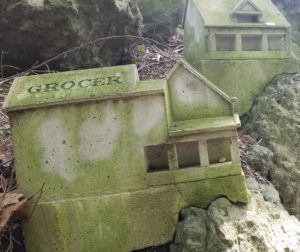
The visual treats of Forest Hills Cemetery aren’t limited just to gravestones and monuments. Cemetery officials have put a lot of effort into integrating contemporary art into the landscape. Here are just a couple of my favorites:
The miniature village. Along one of the paths that wind through the cemetery is a cluster of tiny houses created by artist Christopher Frost. According to Frost, each house represents the lifetime dwelling of a noted individual who is buried nearby.
Nightshirts. This is the title of my all-time favorite art installation at the cemetery, which, sadly, is no longer on the grounds. Created by Leslie Wilcox, the installation consisted of five Victorian-era nightshirts crafted out of translucent stainless steel mesh and arranged so they seemed to hover around a nineteenth-century gravesite.
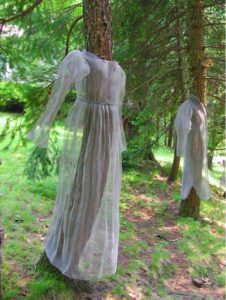
The nightshirts reminded me of ghosts, but I always found them more comforting than scary. If there is to be an afterworld, let me roam it in pajamas.
